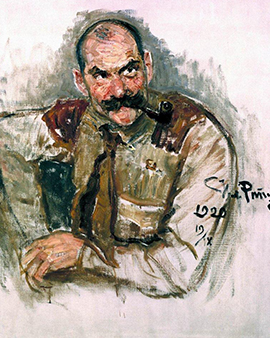Akseli Gallen-Kallela is one of the most famous Finnish artists. He was born in Pori in 1865 with the civil name Axel Waldemar Gallén. He became known for his detailed illustrations of the Finnish national epic Kalevala. In this way, the artist had a significant influence on Finnish identity. The Kalevala is one of the most important literary works in the Finnish language.
Even today Gallen-Kallela is considered one of the most important representatives of Finnish national romanticism and sculpture. The artist was also engaged in architecture and design. Unsurprisingly, he designed his own home and studio. Today, as a museum, the buildings offer an exciting insight into the artist's work. Gallen-Kallela came from a middle-class family. At the age of eleven he attended a boarding school in Helsinki. It was at this time that his interest in art developed. In his free time he attended drawing classes to learn different techniques. At the age of 19, he left his home country to study painting at the Académie Julian in Paris. There he met artists and companions, including the Finnish painter Albert Edelfelt and the Swedish writer August Strindberg. After his studies, his life took him back to his homeland. There he married and in the following years three children were born.
His style changed over time. The artist's early works were in realism. After his time in France, elements of French Symbolism and Art Nouveau were increasingly found in his works. In addition to painting, he created frescoes, devoted himself to sculpture and illustrated other works of Finnish literature. For a time, Akseli Gallen-Kallela was a member of the artists' association "Die Brücke", which was joined by numerous expressionists and pioneers of modernism. He quickly realized that he did not share their views and left the group soon after. In 1895 his works were exhibited together with those of Munch in Berlin. One of his career highlights was representing Finland at the Venice Biennale. The artist, who loved to experiment, tried out numerous styles. But all his works have one thing in common: a close thematic connection with his native Finland and the culture and tradition there. All the more surprising is his departure for faraway places in 1909, when he spent almost two years with his family in British East Africa. At this time, he created nearly 150 expressionist paintings. In his eventful life, Akseli Gallen-Kallela met many famous and influential people, including Maxim Gorky and Gustav Mahler. He portrayed influential artists of his time, including Edvard Munch and Jean Sibelius. He spent his last years with his family in the American artists' colony of Taos. There, too, Finnish mythology was among his favorite pictorial motifs. In 1926 he returned to his homeland, where he died of pneumonia in 1931.
×





.jpg)
.jpg)
.jpg)
.jpg)
.jpg)
.jpg)
.jpg)
.jpg)
.jpg)
.jpg)
.jpg)
.jpg)
.jpg)
.jpg)
.jpg)
.jpg)
.jpg)
.jpg)
.jpg)
.jpg)
.jpg)
.jpg)
.jpg)
.jpg)
.jpg)
.jpg)
.jpg)
.jpg)
.jpg)
.jpg)
.jpg)
.jpg)
.jpg)
.jpg)
.jpg)
.jpg)
.jpg)
.jpg)
.jpg)
.jpg)
.jpg)
.jpg)
.jpg)
.jpg)
.jpg)
.jpg)
.jpg)
.jpg)
.jpg)
.jpg)
.jpg)
.jpg)
.jpg)
.jpg)
.jpg)
.jpg)
.jpg)
.jpg)
.jpg)
.jpg)
.jpg)
.jpg)
.jpg)
.jpg)
.jpg)
.jpg)
.jpg)
.jpg)
.jpg)
.jpg)
.jpg)
.jpg)
.jpg)
.jpg)
.jpg)
.jpg)
.jpg)
.jpg)
.jpg)
.jpg)
.jpg)
.jpg)
.jpg)
.jpg)
.jpg)
.jpg)
.jpg)
.jpg)
.jpg)
.jpg)
.jpg)
.jpg)
.jpg)
.jpg)
.jpg)
.jpg)
.jpg)
.jpg)
.jpg)
.jpg)
.jpg)
.jpg)
.jpg)
.jpg)
.jpg)
.jpg)
.jpg)
.jpg)
.jpg)
.jpg)
_-_(MeisterDrucke-1619972).jpg)
_-_(MeisterDrucke-1619972).jpg)
.jpg)
.jpg)
.jpg)
.jpg)
.jpg)
.jpg)
.jpg)
.jpg)
.jpg)
.jpg)
.jpg)
.jpg)
.jpg)
.jpg)






